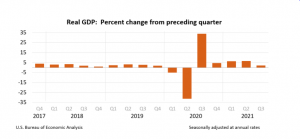Date: November 24, 2021
Real gross domestic product (GDP) rose at an annual rate of 2.1 percent in the third quarter of 2021 according to the “second” estimate released by the Bureau of Economic Analysis. In the second quarter, real GDP rose 6.7 percent.

COVID-19 Impact on the Third-Quarter 2021 GDP Estimate
The rise in third-quarter GDP reflected the continued economic impact of the COVID-19 pandemic. A resurgence of COVID-19 cases resulted in new restrictions and delays in the reopening of establishments in some parts of the country. Government assistance payments in the form of forgivable loans to businesses, grants to state and local governments, and social benefits to households all fell.
The rise in real GDP in the third quarter reflected rises in private inventory investment, PCE, state and local government spending, and nonresidential fixed investment that were partly offset by falls in residential fixed investment, federal government spending, and exports. Imports, which are a subtraction in the calculation of GDP, grew.
The climb in private inventory investment reflected rises in wholesale trade (led by nondurable goods industries) and in retail trade (led by motor vehicles and parts dealers). The climb in PCE reflected a rise in services that was partly offset by a fall in goods. Within services, rises were widespread with the largest contributions coming from “other” services (mainly international travel), transportation services, and health care. The fall in goods primarily reflected a fall in spending on motor vehicles and parts. The rise in state and local government spending was led by employee compensation (notably, education). The rise in nonresidential fixed investment reflected a rise in intellectual property products (led by software and research and development) that was partly offset by falls in structures and equipment.
The fall in residential fixed investment primarily reflected falls in improvements and in new single-family structures. The fall in federal government spending primarily reflected a fall in non-defense spending on intermediate goods and services after the processing and administration of Paycheck Protection Program loan applications by banks on behalf of the federal government ended in the second quarter. The fall in exports reflected a fall in goods that was partly offset by a rise in services. The rise in imports primarily reflected a rise in services (led by travel and transport).
The deceleration in real GDP in the third quarter was more than accounted for by a slowdown in PCE. From the second quarter to the third quarter, spending for goods turned down (led by motor vehicles and parts) and services decelerated (led by food services and accommodations).
Current dollar GDP rose 8.1 percent at an annual rate, or $446.0 billion, in the third quarter to a level of $23.19 trillion. In the second quarter, GDP rose 13.4 percent, or $702.8 billion.
The price index for gross domestic purchases rose 5.5 percent in the third quarter, compared with a rise of 5.8 percent in the second quarter. The PCE price index rose 5.3 percent, compared with a climb of 6.5 percent. Excluding food and energy prices, the PCE price index rose 4.5 percent, compared with a climb of 6.1 percent.
Gross Domestic Income and Corporate Profits
Real gross domestic income (GDI) rose 6.7 percent in the third quarter, compared with a climb of 4.3 percent (revised) in the second quarter. The average of real GDP and real GDI, a supplemental measure of U.S. economic activity that equally weights GDP and GDI, rose 4.4 percent in the third quarter, compared with a climb of 5.5 percent in the second quarter.
Profits from current production (corporate profits with inventory valuation and capital consumption adjustments) rose $121.4 billion in the third quarter, compared with a rise of $267.8 billion in the second quarter
Profits of domestic financial corporations rose $13.7 billion in the third quarter, compared with a rise of $52.8 billion in the second quarter. Profits of domestic nonfinancial corporations rose $67.5 billion, compared with a rise of $221.3 billion. Rest-of-the-world profits rose $40.1 billion, in contrast to a fall of $6.2 billion. In the third quarter, receipts rose $43.1 billion, and payments rose $3.0 billion.
Disclaimer:
Analyst Certification -The views expressed in this research report accurately reflect the personal views of Mayberry Investments Limited Research Department about those issuer(s) or securities as at the date of this report. Each research analyst (s) also certify that no part of their compensation was, is, or will be, directly or indirectly, related to the specific recommendation(s) or view(s) expressed by that research analyst in this research report.
Company Disclosure -The information contained herein has been obtained from sources believed to be reliable, however its accuracy and completeness cannot be guaranteed. You are hereby notified that any disclosure, copying, distribution or taking any action in reliance on the contents of this information is strictly prohibited and may be unlawful. Mayberry may effect transactions or have positions in securities mentioned herein. In addition, employees of Mayberry may have positions and effect transactions in the securities mentioned herein.
